Rome
Rome
Roma ( Saint Peter's Basilica | |
|---|---|
|
Latin )The Eternal City
| |
UTC+2 (CEST) | |
| CAP code(s) | 00100; 00118 to 00199 |
| Area code | 06 |
| Website | comune.roma.it |
| Official name | Historic Centre of Rome, the Properties of the Holy See in that City Enjoying Extraterritorial Rights and San Paolo Fuori le Mura |
| Reference | 91 |
| Inscription | 1980 (4th Session) |
| Area | 1,431 ha (3,540 acres) |
Rome (Italian and Latin: Roma, Italian: [ˈroːma] ⓘ) is the capital city of Italy. It is also the capital of the Lazio region, the centre of the Metropolitan City of Rome Capital, and a special comune (municipality) named Comune di Roma Capitale. With 2,860,009 residents in 1,285 km2 (496.1 sq mi),[2] Rome is the country's most populated comune and the third most populous city in the European Union by population within city limits. The Metropolitan City of Rome, with a population of 4,355,725 residents, is the most populous metropolitan city in Italy.[3] Its metropolitan area is the third-most populous within Italy.[5] Rome is located in the central-western portion of the Italian Peninsula, within Lazio (Latium), along the shores of the Tiber. Vatican City (the smallest country in the world)[6] is an independent country inside the city boundaries of Rome, the only existing example of a country within a city. Rome is often referred to as the City of Seven Hills due to its geographic location, and also as the "Eternal City". Rome is generally considered to be the cradle of Western civilization and Western Christian culture, and the centre of the Catholic Church.[7][8][9]
After the
In 2019, Rome was the 14th most visited city in the world, with 8.6 million tourists, the third most visited city in the European Union, and the most popular tourist destination in Italy.
Name and symbol
Etymology
According to the Ancient Romans'
However, it is possible that the name Romulus was actually derived from Rome itself.[21] As early as the 4th century, there have been alternative theories proposed on the origin of the name Roma. Several hypotheses have been advanced focusing on its linguistic roots which however remain uncertain:[22]
- From Rumon or Rumen, archaic name of the Tiber, which in turn is supposedly related to the Greek verb ῥέω (rhéō) 'to flow, stream' and the Latin verb ruō 'to hurry, rush';[b]
- From the Etruscan word 𐌓𐌖𐌌𐌀 (ruma), whose root is *rum- "teat", with possible reference either to the totem wolf that adopted and suckled the cognately named twins Romulus and Remus, or to the shape of the Palatine and Aventine Hills;
- From the Greek word ῥώμη (rhṓmē), which means strength.[c]
Other names and symbols
Rome has also been called in ancient times simply "Urbs" (central city),
History
Earliest history
Papal States 1849–1870
Kingdom of Italy 1870–1943
Italian Social Republic 1943–1944
Kingdom of Italy 1944–1946
Italian Republic

While there have been discoveries of archaeological evidence of human occupation of the Rome area from approximately 14,000 years ago, the dense layer of much younger debris obscures
Legend of the founding of Rome

Traditional stories handed down by the
Monarchy and republic


After the foundation by Romulus according to a legend,
In 509 BC, the Romans expelled the last king from their city and established an
The third and second century BC saw the establishment of Roman hegemony over the
From the beginning of the 2nd century BC, power was contested between two groups of aristocrats: the
The conquest of
Empire
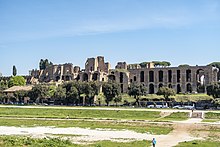
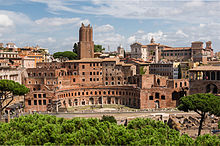
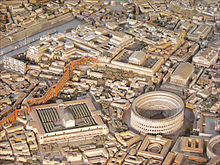
In 27 BC, Octavian became

After the end of the Severan Dynasty in 235, the Empire entered into a 50-year period known as the
After the abdication of Diocletian and Maximian in 305 and a series of civil wars between rival claimants to imperial power, during the years 306–313, the Tetrarchy was abandoned. Constantine the Great undertook a major reform of the bureaucracy, not by changing the structure but by rationalising the competencies of the several ministries during the years 325–330, after he defeated Licinius, emperor in the East, at the end of 324. The so-called Edict of Milan of 313, actually a fragment of a letter from Licinius to the governors of the eastern provinces, granted freedom of worship to everyone, including Christians, and ordered the restoration of confiscated church properties upon petition to the newly created vicars of dioceses. He funded the building of several churches and allowed clergy to act as arbitrators in civil suits (a measure that did not outlast him but which was restored in part much later). He transformed the town of Byzantium into his new residence, which, however, was not officially anything more than an imperial residence like Milan or Trier or Nicomedia until given a city prefect in May 359 by Constantius II; Constantinople.[46]
Christianity in the form of the Nicene Creed became the official religion of the empire in 380, via the

Rome, which had lost its central role in the administration of the empire,
The decline of the city's population was caused by the loss of grain shipments from North Africa, from 440 onward, and the unwillingness of the senatorial class to maintain donations to support a population that was too large for the resources available. Even so, strenuous efforts were made to maintain the monumental centre, the palatine, and the largest baths, which continued to function until the Gothic siege of 537. The large baths of Constantine on the Quirinale were even repaired in 443, and the extent of the damage exaggerated and dramatised.[50]
However, the city gave an appearance overall of shabbiness and decay because of the large abandoned areas due to population decline. The population declined to 500,000 by 452 and 100,000 by 500 AD (perhaps larger, though no certain figure can be known). After the Gothic siege of 537, the population dropped to 30,000 but had risen to 90,000 by the papacy of Gregory the Great.[51] The population decline coincided with the general collapse of urban life in the West in the fifth and sixth centuries, with few exceptions. Subsidized state grain distributions to the poorer members of society continued right through the sixth century and probably prevented the population from falling further.[52] The figure of 450,000–500,000 is based on the amount of pork, 3,629,000 lbs. distributed to poorer Romans during five winter months at the rate of five Roman lbs per person per month, enough for 145,000 persons or 1/4 or 1/3 of the total population.[53] Grain distribution to 80,000 ticket holders at the same time suggests 400,000 (Augustus set the number at 200,000 or one-fifth of the population).
Middle Ages
After the
The Bishop of Rome, called the
After the
In 846, Muslim Arabs
During this period, the city was autonomously ruled by a senatore or patrizio. In the 12th century, this administration, like other European cities, evolved into the
In this period, the papacy played a role of secular importance in Western Europe, often acting as arbitrators between Christian monarchs and exercising additional political powers.[62][63][64]
In 1266,
Early modern history
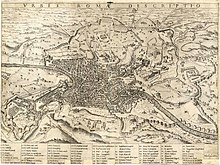


In 1418, the
During those years, the centre of the Italian Renaissance moved to Rome from Florence. Majestic works, as the new Saint Peter's Basilica, the Sistine Chapel and Ponte Sisto (the first bridge to be built across the Tiber since antiquity, although on Roman foundations) were created. To accomplish that, the Popes engaged the best artists of the time, including Michelangelo, Perugino, Raphael, Ghirlandaio, Luca Signorelli, Botticelli, and Cosimo Rosselli.
The period was also infamous for papal corruption, with many Popes fathering children, and engaging in
The Renaissance period changed the face of Rome dramatically, with works like the Pietà by Michelangelo and the frescoes of the Borgia Apartments. Rome reached the highest point of splendour under Pope Julius II (1503–1513) and his successors Leo X and Clement VII, both members of the Medici family.


In this twenty-year period, Rome became one of the greatest centres of art in the world. The old St. Peter's Basilica built by Emperor Constantine the Great[66] (which by then was in a dilapidated state) was demolished and a new one begun. The city hosted artists like Ghirlandaio, Perugino, Botticelli and Bramante, who built the temple of San Pietro in Montorio and planned a great project to renovate the Vatican. Raphael, who in Rome became one of the most famous painters of Italy, created frescoes in the Villa Farnesina, the Raphael's Rooms, plus many other famous paintings. Michelangelo started the decoration of the ceiling of the Sistine Chapel and executed the famous statue of the Moses for the tomb of Julius II.
Its economy was rich, with the presence of several Tuscan bankers, including Agostino Chigi, who was a friend of Raphael and a patron of arts. Before his early death, Raphael also promoted for the first time the preservation of the ancient ruins. The War of the League of Cognac caused the first plunder of the city in more than five hundred years since the previous sack; in 1527, the Landsknechts of Emperor Charles V sacked the city, bringing an abrupt end to the golden age of the Renaissance in Rome.[65]
Beginning with the
This was another nepotistic age; the new aristocratic families (
Late modern and contemporary
The rule of the Popes was interrupted by the short-lived
In 1849,
Rome then became the focus of hopes of Italian reunification after the rest of Italy was united as the Kingdom of Italy in 1861 with the temporary capital in Florence. That year Rome was declared the capital of Italy even though it was still under the Pope's control. During the 1860s, the last vestiges of the Papal States were under French protection thanks to the foreign policy of Napoleon III. French troops were stationed in the region under Papal control. In 1870 the French troops were withdrawn due to the outbreak of the Franco-Prussian War. Italian troops were able to capture Rome entering the city through a breach near Porta Pia. Pope Pius IX declared himself a prisoner in the Vatican. In 1871 the capital of Italy was moved from Florence to Rome.[68] In 1870 the population of the city was 212,000, all of whom lived with the area circumscribed by the ancient city, and in 1920, the population was 660,000. A significant portion lived outside the walls in the north and across the Tiber in the Vatican area.
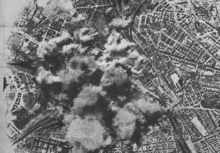
Soon after World War I in late 1922 Rome witnessed the rise of
Rome developed greatly after the war as part of the "
Geography
Location

Rome is in the Lazio region of central Italy on the Tiber (Italian: Tevere) river. The original settlement developed on hills that faced onto a ford beside the Tiber Island, the only natural ford of the river in this area. The Rome of the Kings was built on seven hills: the Aventine Hill, the Caelian Hill, the Capitoline Hill, the Esquiline Hill, the Palatine Hill, the Quirinal Hill, and the Viminal Hill. Modern Rome is also crossed by another river, the Aniene, which flows into the Tiber north of the historic centre.
Although the city centre is about 24 km (15 mi) inland from the
Parks and gardens

Public parks and nature reserves cover a large area in Rome, and the city has one of the largest areas of green space among European capitals.
Climate

Rome has a
Its average annual temperature is above 21 °C (70 °F) during the day and 9 °C (48 °F) at night. In the coldest month, January, the average temperature is 12.6 °C (54.7 °F) during the day and 2.1 °C (35.8 °F) at night. In the warmest month, August, the average temperature is 31.7 °C (89.1 °F) during the day and 17.3 °C (63.1 °F) at night.
December, January and February are the coldest months, with a daily mean temperature of approximately 8 °C (46 °F). Temperatures during these months generally vary between 10 and 15 °C (50 and 59 °F) during the day and between 3 and 5 °C (37 and 41 °F) at night, with colder or warmer spells occurring frequently. Snowfall is rare but not unheard of, with light snow or flurries occurring on some winters, generally without accumulation, and major snowfalls on a very rare occurrence (the most recent ones were in 2018, 2012 and 1986).[74][75][76]
The average
The highest temperature ever recorded in Rome was 42.9 °C (109.2 °F) on 18 July 2023.[78]
| Climate data for Rome Ciampino Airport, elevation: 129 m or 423 ft, 1991-2020 normals, extremes 1944–present | |||||||||||||
|---|---|---|---|---|---|---|---|---|---|---|---|---|---|
| Month | Jan | Feb | Mar | Apr | May | Jun | Jul | Aug | Sep | Oct | Nov | Dec | Year |
| Record high °C (°F) | 20.8 (69.4) |
23.0 (73.4) |
26.6 (79.9) |
30.0 (86.0) |
34.2 (93.6) |
39.3 (102.7) |
40.0 (104.0) |
40.6 (105.1) |
40.0 (104.0) |
32.0 (89.6) |
26.1 (79.0) |
21.2 (70.2) |
40.6 (105.1) |
| Mean daily maximum °C (°F) | 12.0 (53.6) |
13.0 (55.4) |
15.8 (60.4) |
18.8 (65.8) |
22.3 (72.1) |
28.1 (82.6) |
31.0 (87.8) |
31.6 (88.9) |
26.7 (80.1) |
22.2 (72.0) |
16.9 (62.4) |
12.7 (54.9) |
21.0 (69.8) |
| Daily mean °C (°F) | 7.5 (45.5) |
8.0 (46.4) |
10.7 (51.3) |
13.6 (56.5) |
18.0 (64.4) |
22.5 (72.5) |
25.1 (77.2) |
25.4 (77.7) |
21.0 (69.8) |
17.0 (62.6) |
12.4 (54.3) |
8.5 (47.3) |
15.8 (60.4) |
| Mean daily minimum °C (°F) | 3.4 (38.1) |
3.4 (38.1) |
5.9 (42.6) |
8.6 (47.5) |
12.6 (54.7) |
16.7 (62.1) |
19.3 (66.7) |
19.8 (67.6) |
16.0 (60.8) |
12.4 (54.3) |
8.5 (47.3) |
4.7 (40.5) |
10.9 (51.6) |
| Record low °C (°F) | −11.0 (12.2) |
−6.9 (19.6) |
−6.5 (20.3) |
−2.4 (27.7) |
1.8 (35.2) |
5.6 (42.1) |
9.1 (48.4) |
9.3 (48.7) |
4.3 (39.7) |
0.8 (33.4) |
−5.2 (22.6) |
−6.6 (20.1) |
−11.0 (12.2) |
| Average precipitation mm (inches) | 65.6 (2.58) |
62.8 (2.47) |
58.6 (2.31) |
68.6 (2.70) |
56.9 (2.24) |
30.1 (1.19) |
19.8 (0.78) |
30.2 (1.19) |
64.9 (2.56) |
88.1 (3.47) |
108.2 (4.26) |
98.3 (3.87) |
752.0 (29.61) |
| Average precipitation days (≥ 1.0 mm) | 7.40 | 7.48 | 6.85 | 7.42 | 5.54 | 3.38 | 2.16 | 2.20 | 6.00 | 7.32 | 8.84 | 9.44 | 74.03 |
| Average relative humidity (%)
|
75.8 | 71.5 | 70.6 | 70.4 | 69.0 | 65.4 | 63.3 | 64.1 | 69.1 | 74.0 | 77.9 | 77.2 | 70.7 |
| Average dew point °C (°F) | 3.9 (39.0) |
3.5 (38.3) |
5.8 (42.4) |
8.5 (47.3) |
12.1 (53.8) |
15.1 (59.2) |
16.9 (62.4) |
17.7 (63.9) |
15.5 (59.9) |
12.9 (55.2) |
9.3 (48.7) |
5.2 (41.4) |
10.5 (50.9) |
| Mean monthly sunshine hours | 155.9 | 171.9 | 203.1 | 221.1 | 276.5 | 298.8 | 337.6 | 320.2 | 237.9 | 200.6 | 153.3 | 146.9 | 2,723.9 |
| Source 1: NOAA[79] | |||||||||||||
| Source 2: Temperature extreme in Toscana[80] | |||||||||||||
Demographics
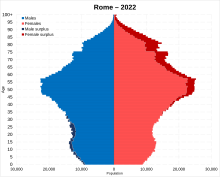
| Year | Pop. | ±% |
|---|---|---|
| 1861 | 194,500 | — |
| 1871 | 212,432 | +9.2% |
| 1881 | 273,952 | +29.0% |
| 1901 | 422,411 | +54.2% |
| 1911 | 518,917 | +22.8% |
| 1921 | 660,235 | +27.2% |
| 1931 | 930,926 | +41.0% |
| 1936 | 1,150,589 | +23.6% |
| 1951 | 1,651,754 | +43.6% |
| 1961 | 2,188,160 | +32.5% |
| 1971 | 2,781,993 | +27.1% |
| 1981 | 2,840,259 | +2.1% |
| 1991 | 2,775,250 | −2.3% |
| 2001 | 2,663,182 | −4.0% |
| 2011 | 2,617,175 | −1.7% |
| 2021 | 2,770,226 | +5.8% |
| Source: ISTAT , 2022 | ||
By 550 BC, Rome was the second largest city in Italy after only Taras (modern
The size of the city at the time of the Emperor Augustus is a matter of speculation, with estimates based on grain distribution, grain imports, aqueduct capacity, city limits, population density, census reports, and assumptions about the number of unreported women, children and slaves providing a very wide range. Glenn Storey estimates 450,000 people, Whitney Oates estimates 1.2 million, Neville Morely provides a rough estimate of 800,000 and excludes earlier suggestions of 2 million.[89][90][91][92] Estimates of the city's population towards and after the end of the Roman empire also vary. A.H.M. Jones estimated the population at 650,000 in the mid-fifth century. The damage caused by the sackings may have been overestimated. The population had already started to decline from the late fourth century onward, although around the middle of the fifth century it seems that Rome continued to be the most populous city of the two parts of the Empire.[93] According to Krautheimer it was still close to 800,000 in 400 AD; had declined to 500,000 by 452, and dwindled to perhaps 100,000 in 500 AD. After the Gothic Wars, 535–552, the population may have dwindled temporarily to 30,000. During the pontificate of Pope Gregory I (590–604), it may have reached 90,000, augmented by refugees.[94] Lancon estimates 500,000 based on the number of 'incisi' enrolled as eligible to receive bread, oil and wine rations; the number fell to 120,000 in the reform of 419.[95] Neil Christie, citing free rations for the poorest, estimated 500,000 in the mid-fifth century and still a quarter of a million at the end of the century.[96] Novel 36 of Emperor Valentinian III records 3.629 million pounds of pork to be distributed to the needy at 5 lbs. per month for the five winter months, sufficient for 145,000 recipients. This has been used to suggest a population of just under 500,000. Supplies of grain remained steady until the seizure of the remaining provinces of North Africa in 439 by the Vandals, and may have continued to some degree afterwards for a while. The city's population declined to less than 50,000 people in the Early Middle Ages from 700 AD onward. It continued to stagnate or shrink until the Renaissance.[97]
When the Kingdom of Italy annexed Rome in 1870, the city had a population of about 225,000. Less than half the city within the walls was built up in 1881 when the population recorded was 275,000. This increased to 600,000 by the eve of World War I. The Fascist regime of Mussolini tried to block an excessive demographic rise of the city but failed to prevent it from reaching one million people by the early 1930s.[citation needed][clarification needed] Population growth continued after the Second World War, helped by a post-war economic boom. A construction boom also created many suburbs during the 1950s and 1960s.
In mid-2010, there were 2,754,440 residents in the city proper, while some 4.2 million people lived in the greater Rome area (which can be approximately identified with its administrative metropolitan city, with a population density of about 800 inhabitants/km2 stretching over more than 5,000 km2 (1,900 sq mi)). Minors (children ages 18 and younger) totalled 17.00% of the population compared to pensioners who number 20.76%. This compares with the Italian average of 18.06% (minors) and 19.94% (pensioners). The average age of a Roman resident is 43 compared to the Italian average of 42. In the five years between 2002 and 2007, the population of Rome grew by 6.54%, while Italy as a whole grew by 3.56%.[98] The current[when?] birth rate of Rome is 9.10 births per 1,000 inhabitants compared to the Italian average of 9.45 births.[citation needed]
The urban area of Rome extends beyond the administrative city limits with a population of around 3.9 million.[99] Between 3.2 and 4.2 million people live in the Rome metropolitan area.[100][101][102][103][104]
Origin groups

According to the latest statistics conducted by ISTAT,[105] approximately 9.5% of the population consists of non-Italians. About half of the immigrant population consists of those of various other European origins (chiefly Romanian, Polish, Ukrainian, and Albanian) numbering a combined total of 131,118 or 4.7% of the population. The remaining 4.8% are those with non-European origins, chiefly Filipinos (26,933), Bangladeshis (12,154), and Chinese (10,283).
The
Language

Rome's historic contribution to language in a worldwide sense is much more extensive, however. Through the process of
The medieval
Religion

Much like the rest of Italy, Rome is predominantly
Despite the fact that Rome is home to the
Since the end of the
The territory of Vatican City is part of the Mons Vaticanus (Vatican Hill), and of the adjacent former Vatican Fields, where St. Peter's Basilica, the Apostolic Palace, the Sistine Chapel, and museums were built, along with various other buildings. The area was part of the Roman rione of Borgo until 1929. Being separated from the city on the west bank of the Tiber, the area was a suburb that was protected by being included within the walls of Leo IV, later expanded by the current fortification walls of Paul III, Pius IV, and Urban VIII. When the Lateran Treaty of 1929 that created the Vatican state was being prepared, the boundaries of the proposed territory were influenced by the fact that much of it was all but enclosed by this loop.
Rome has been a major
Government
Rome constitutes a comune speciale, named "Roma Capitale",[114] and is the largest both in terms of land area and population among the 8,101 comuni of Italy. It is governed by a mayor and a city council. The seat of the comune is the Palazzo Senatorio on the Capitoline Hill, the historic seat of the city government. The local administration in Rome is commonly referred to as "Campidoglio", the Italian name of the hill.
Since 1972, the city has been divided into administrative areas, called municipi (sing. municipio) (until 2001 named circoscrizioni).[115] They were created for administrative reasons to increase decentralisation in the city. Each municipio is governed by a president and a council of twenty-five members who are elected by its residents every five years. The municipi frequently cross the boundaries of the traditional, non-administrative divisions of the city. The municipi were originally 20, then 19,[116] and in 2013, their number was reduced to 15.[117]
Rome is also divided into differing types of non-administrative units. The historic centre is divided into 22
Rome is the principal town of the
Rome is the national capital of Italy and is the seat of the
International relations
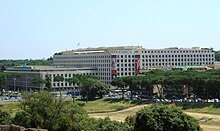
Among the
Rome has traditionally been involved in the process of European political integration. The
Twin towns and sister cities
Since 9 April 1956, Rome is exclusively and reciprocally
 Paris, France, 1956
Paris, France, 1956
- Solo Parigi è degna di Roma; solo Roma è degna di Parigi. (in Italian)
- Seule Paris est digne de Rome; seule Rome est digne de Paris. (in French)
- "Only Paris is worthy of Rome; only Rome is worthy of Paris."[123][124][125][126][127]
Rome's other partner cities are:[128]
 Achacachi, Bolivia[128]
Achacachi, Bolivia[128] Algiers, Algeria[128]
Algiers, Algeria[128] Beijing, China[129][130]
Beijing, China[129][130] Belgrade, Serbia[128]
Belgrade, Serbia[128] Brasília, Brazil[128]
Brasília, Brazil[128] Buenos Aires, Argentina[128]
Buenos Aires, Argentina[128] Cairo, Egypt[128]
Cairo, Egypt[128] Cincinnati, United States[128]
Cincinnati, United States[128] Kyiv, Ukraine[128]
Kyiv, Ukraine[128] Kobanî, Syria[131]
Kobanî, Syria[131] Kraków, Poland[132]
Kraków, Poland[132] Madrid, Spain[133]
Madrid, Spain[133] Multan, Pakistan[134]
Multan, Pakistan[134] New Delhi, India[128]
New Delhi, India[128] New York City, United States[135]
New York City, United States[135] Plovdiv, Bulgaria[128]
Plovdiv, Bulgaria[128] Seoul, South Korea[136][137]
Seoul, South Korea[136][137] Sydney, Australia[128]
Sydney, Australia[128] Tirana, Albania[138][139]
Tirana, Albania[138][139] Tehran, Iran[128]
Tehran, Iran[128] Tokyo, Japan[140]
Tokyo, Japan[140] Tongeren, Belgium[128]
Tongeren, Belgium[128] Tunis, Tunisia[141]
Tunis, Tunisia[141] Washington, D.C., United States[142]
Washington, D.C., United States[142]
Economy
As the capital of Italy, Rome hosts all the principal institutions of the nation, including the Presidency of the Republic, the government (and its single Ministeri), the Parliament, the main judicial Courts, and the diplomatic representatives of all the countries for the states of Italy and Vatican City. Many international institutions are located in Rome, notably cultural and scientific ones, such as the American Institute, the British School, the French Academy, the Scandinavian Institutes, and the German Archaeological Institute. There are also specialised agencies of the United Nations, such as the
According to the GaWC study of world cities, Rome is a "Beta +" city.[145] The city was ranked in 2014 as 32nd in the Global Cities Index, the highest in Italy.[146] With a 2005 GDP of €94.376 billion (US$121.5 billion),[147][needs update] the city produces 6.7% of the national GDP (more than any other single city in Italy), and its unemployment rate, lowered from 11.1% to 6.5% between 2001 and 2005, is now one of the lowest rates of all the European Union capital cities.[147] Rome's economy grows at around 4.4% annually and continues to grow at a higher rate in comparison to any other city in the rest of the country.[147] This means that were Rome a country, it would be the world's 52nd richest country by GDP, near to the size to that of Egypt. Rome also had a 2003 GDP per capita of €29,153 (US$37,412), which was second in Italy (after Milan), and is more than 134.1% of the EU average GDP per capita.[148][needs update] Rome, on the whole, has the highest total earnings in Italy, reaching €47,076,890,463 in 2008,[149][needs update] yet, in terms of average workers' incomes, the city places itself 9th in Italy, with €24,509.[149] On a global level, Rome's workers receive the 30th highest wages in 2009, coming three places higher than in 2008, in which the city ranked 33rd.[150][needs update] The Rome area had a GDP amounting to $167.8 billion, and $38,765 per capita.[151]
Although the economy of Rome is characterised by the absence of heavy industry, and it is largely dominated by
Universities, national radio and television and the movie industry in Rome are also important parts of the economy: Rome is also the hub of the
Tourism


Rome today is one of the most important tourist destinations of the world, due to the incalculable immensity of its archaeological and artistic treasures, as well as for the charm of its unique traditions, the beauty of its panoramic views, and the majesty of its magnificent "villas" (parks). Among the most significant resources are the many museums –
Rome is a major archaeological hub, and one of the world's main centres of archaeological research. There are numerous cultural and research institutes located in the city, such as the American Academy in Rome,[155] and The Swedish Institute at Rome.[156] Rome contains numerous ancient sites, including the Forum Romanum, Trajan's Market, Trajan's Forum,[157] the Colosseum, and the Pantheon, to name but a few. The Colosseum, arguably one of Rome's most iconic archaeological sites, is regarded as a wonder of the world.[158][159]
Rome contains a vast collection of art, sculpture,
Rome has a growing stock of contemporary and modern art and architecture. The National Gallery of Modern Art has works by Balla, Morandi, Pirandello, Carrà, De Chirico, De Pisis, Guttuso, Fontana, Burri, Mastroianni, Turcato, Kandisky, and Cézanne on permanent exhibition. 2010 saw the opening of Rome's newest arts foundation, a contemporary art and architecture gallery designed by acclaimed Iraqi architect Zaha Hadid. Known as
Education
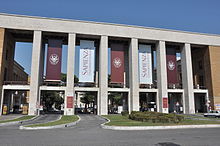
Rome is a nationwide and major international centre for higher education, containing numerous academies, colleges and universities. It boasts a large variety of academies and colleges, and has always been a major worldwide intellectual and educational centre, especially during Ancient Rome and the Renaissance, along with Florence.[167] According to the City Brands Index, Rome is considered the world's second most historically, educationally and culturally interesting and beautiful city.[168]
Rome has many universities and colleges. Its first university,

Rome contains many
Culture
Architecture
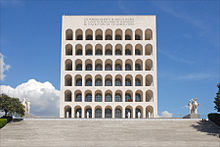
Fountains and aqueducts

Rome is a city known for its numerous fountains, built-in all different styles, from Classical and Medieval, to Baroque and Neoclassical. The city has had
During the 17th and 18th century, the Roman popes reconstructed other degraded Roman aqueducts and built new display fountains to mark their termini, launching the golden age of the Roman fountain. The fountains of Rome, like the paintings of Rubens, were expressions of the new style of Baroque art. In these fountains, sculpture became the principal element, and the water was used simply to animate and decorate the sculptures. They, like baroque gardens, were "a visual representation of confidence and power".[180]
Statues
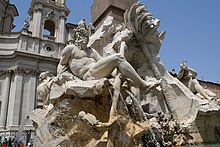
Rome is well known for its statues but, in particular, the
Obelisks and columns

The city hosts eight
Bridges

The city of Rome contains numerous famous bridges which cross the
Catacombs

Rome has an extensive amount of ancient catacombs, or underground burial places under or near the city, of which there are at least forty, some discovered only in recent decades. Though most famous for Christian burials, they include pagan and Jewish burials, either in separate catacombs or mixed together. The first large-scale catacombs were excavated from the 2nd century onwards. Originally they were carved through tuff, a soft volcanic rock, outside the boundaries of the city, because Roman law forbade burial places within city limits. Currently, maintenance of the catacombs is in the hands of the Papacy which has invested in the Salesians of Don Bosco the supervision of the Catacombs of St. Callixtus on the outskirts of Rome.
Entertainment and performing arts

Rome is an important centre for music, and it has an intense musical scene, including several prestigious music conservatories and theatres. It hosts the
Rome has also had a major impact on music history. The Roman School was a group of composers of predominantly church music, which were active in the city during the 16th and 17th centuries, therefore spanning the late Renaissance and early Baroque eras. The term also refers to the music they produced. Many of the composers had a direct connection to the Vatican and the papal chapel, though they worked at several churches; stylistically they are often contrasted with the Venetian School of composers, a concurrent movement which was much more progressive. By far the most famous composer of the Roman School is Giovanni Pierluigi da Palestrina, whose name has been associated for four hundred years with smooth, clear, polyphonic perfection. However, there were other composers working in Rome, and in a variety of styles and forms.
Between 1960 and 1970 Rome was considered to be as a "new Hollywood" because of the many actors and directors who worked there; Via Vittorio Veneto had transformed into a glamour place where you could meet famous people.[185]
Fashion

Rome is also widely recognised as a world fashion capital. Although not as important as Milan, Rome is the fourth most important centre for fashion in the world, according to the 2009 Global Language Monitor after Milan, New York, and Paris, and beating London.[186]
Major luxury fashion houses and jewellery chains, such as
Cuisine

Rome's cuisine has evolved through centuries and periods of social, cultural, and political changes. Rome became a major gastronomical centre during the ancient age. Ancient Roman cuisine was highly influenced by Ancient Greek culture, and after, the empire's enormous expansion exposed Romans to many new, provincial culinary habits and cooking techniques.[188]
Later, during the Renaissance, Rome became well known as a centre of high-cuisine, since some of the best chefs of the time worked for the popes. An example of this was Bartolomeo Scappi, who was a chef working for Pius IV; he acquired fame in 1570 when his cookbook Opera dell'arte del cucinare was published. In the book he lists approximately 1,000 recipes of the Renaissance cuisine and describes cooking techniques and tools, giving the first known picture of a fork.[189]
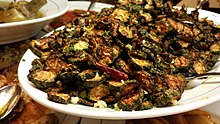
The Testaccio, Rome's trade and slaughterhouse area, was often known as the "belly" or "slaughterhouse" of Rome, and was inhabited by butchers, or vaccinari.[190] The most common or ancient Roman cuisine included the "fifth quarter".[190] The old-fashioned coda alla vaccinara (oxtail cooked in the way of butchers)[190] is still one of the city's most popular meals and is part of most of Rome's restaurants' menus. Lamb is also a very popular part of Roman cuisine, and is often roasted with spices and herbs.[190]
In the modern age, the city developed its own peculiar cuisine, based on products of the nearby Campagna, as lamb and vegetables (globe artichokes are common).[191] In parallel, Roman Jews – present in the city since the 1st century BC – developed their own cuisine, the cucina giudaico-romanesca.
Examples of Roman dishes include
Cinema

Rome hosts the
Founded in 1937 by Benito Mussolini, the studios were bombed by the Western Allies during the Second World War. In the 1950s, Cinecittà was the filming location for several large American film productions, and subsequently became the studio most closely associated with Federico Fellini. Today, Cinecittà is the only studio in the world with pre-production, production, and full post-production facilities on one lot, allowing directors and producers to walk in with their script and "walkout" with a completed film.[citation needed]
Sports
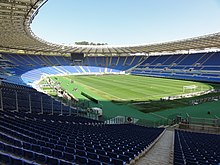
Association football is the most popular sport in Rome, as in the rest of the country. The city hosted the final games of the 1934 and 1990 FIFA World Cup. The latter took place in the Stadio Olimpico, which is also the shared home stadium for local Serie A clubs SS Lazio, founded in 1900, and AS Roma, founded in 1927, whose rivalry in the Derby della Capitale has become a staple of Roman sports culture.[196] Footballers who play for these teams and are also born in the city tend to become especially popular, as has been the case with players such as Francesco Totti and Daniele De Rossi (both for AS Roma), and Alessandro Nesta (for SS Lazio).

Rome hosted the 1960 Summer Olympics, with great success, using many ancient sites such as the Villa Borghese and the Thermae of Caracalla as venues. For the Olympic Games many new facilities were built, notably the new large Olympic Stadium (which was then enlarged and renewed to host several matches and the final of the 1990 FIFA World Cup), the Stadio Flaminio, the Villaggio Olimpico (Olympic Village, created to host the athletes and redeveloped after the games as a residential district), ecc. Rome made a bid to host the 2020 Summer Olympics but it was withdrawn.[197][198]
Further, Rome hosted the EuroBasket 1991 and is home to the internationally recognised basketball team Virtus Roma. Rugby union is gaining wider acceptance. Until 2011 the Stadio Flaminio was the home stadium for the Italy national rugby union team, which has been playing in the Six Nations Championship since 2000. The team now plays home games at the Stadio Olimpico because the Stadio Flaminio needs works of renovation in order to improve both its capacity and safety. Rome is home to local rugby union teams such as Rugby Roma (winner of five Italian championships), Unione Rugby Capitolina and S.S. Lazio Rugby 1927 (rugby union branch of the multisport club S.S. Lazio).
Every May, Rome hosts the ATP Masters Series tennis tournament on the clay courts of the Foro Italico. Cycling was popular in the post-World War II period, although its popularity has faded. Rome has hosted the final portion of the Giro d'Italia three times, in 1911, 1950, and 2009. Other local sports teams include volleyball (M. Roma Volley), handball or waterpolo.
Transport

Rome is at the centre of the radial network of roads that roughly follow the lines of the ancient Roman roads which began at the Capitoline Hill and connected Rome with its empire. Today Rome is circled, at a distance of about 10 km (6 mi) from the Capitol, by the ring-road (the Grande Raccordo Anulare or GRA).
Due to its location in the centre of the Italian peninsula, Rome is the principal railway node for central Italy. Rome's main railway station, Termini, is one of the largest railway stations in Europe and the most heavily used in Italy, with around 400 thousand travellers passing through every day. The second-largest station in the city, Roma Tiburtina, has been redeveloped as a high-speed rail terminus.[199] As well as frequent high-speed day trains to all major Italian cities, Rome is linked nightly by 'boat train' sleeper services to Sicily, and internationally by overnight sleeper services to Munich and Vienna.
Rome is served by three airports. The intercontinental
Although the city has its own quarter on the Mediterranean Sea (Lido di Ostia), this has only a marina and a small channel-harbour for fishing boats. The main harbour which serves Rome is Port of Civitavecchia, located about 62 km (39 mi) northwest of the city.[201]
The city suffers from traffic problems largely due to this radial street pattern, making it difficult for Romans to move easily from the vicinity of one of the radial roads to another without going into the historic centre or using the ring-road. These problems are not helped by the limited size of Rome's metro system when compared to other cities of similar size. Rome has only 21 taxis for every 10,000 inhabitants, far below other major European cities.

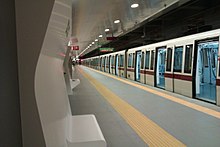
A three-line metro system called the Metropolitana operates in Rome. Construction on the first branch started in the 1930s.[203] The line had been planned to quickly connect the main railway station with the newly planned E42 area in the southern suburbs, where 1942 the World Fair was supposed to be held. The event never took place because of war, but the area was later partly redesigned and renamed Esposizione Universale Roma in the 1950s to serve as a modern business district. The line was finally opened in 1955, and it is now the south part of the B Line.
The A line opened in 1980 from Ottaviano to Anagnina stations, later extended in stages (1999–2000) to Battistini. In the 1990s, an extension of the B line was opened from Termini to Rebibbia. The A and B lines intersect at Roma Termini station. A new branch of the B line (B1) opened on 13 June 2012 after an estimated building cost of €500 million. B1 connects to line B at Piazza Bologna and has four stations over a distance of 3.9 km (2 mi).
A third line, the C line, is under construction with an estimated cost of €3 billion and will have 30 stations over a distance of 25.5 km (16 mi). It will partly replace the existing Termini-Pantano rail line. It will feature full automated, driverless trains.[204] The first section with 15 stations connecting Pantano with the quarter of Centocelle in the eastern part of the city, opened on 9 November 2014.[205] The end of the work was scheduled in 2015, but archaeological findings often delay underground construction work.
A fourth line, D line, is also planned. It will have 22 stations over a distance of 20 km (12 mi). The first section was projected to open in 2015 and the final sections before 2035, but due to the city's financial crisis, the project has been put on hold.
Above-ground public transport in Rome is made up of a bus, tram and urban train network (FR lines). The bus network has in excess of 350 bus lines and over eight thousand bus stops, whereas the more-limited tram system has 39 km (24 mi) of track and 192 stops.[206] There are also trolleybuses.[207]
See also
Notes
- ^ Also the Vatican City
- Maurus Servius Honoratus. However, the Greek verb descends from the Proto-Indo-European root *srew- (compare Ancient Greek ῥεῦμα (rheûma) 'a stream, flow, current', the Thracian river name Στρυμών (Strumṓn) and Proto-Germanic *strauma- 'stream'; if it was related, however, the Latin river name would be expected to begin with **Frum-, like Latin frīgeō 'to freeze' from the root *sreyHg-) and the Latin verb from *h₃rew-.
- ^ This hypothesis originates from Plutarch.
References
- ^ a b "Romulus and Remus". Britannica. 25 November 2014. Archived from the original on 17 March 2015. Retrieved 9 March 2015.
- ^ a b "I numeri di Roma Capitale" (PDF). Comune di Roma. 31 December 2018. Archived (PDF) from the original on 4 May 2020. Retrieved 4 May 2020.
- ^ a b "Popolazione residente al 1° gennaio". Archived from the original on 8 April 2020. Retrieved 10 April 2020.
- ^ "Gross domestic product (GDP) at current market prices by metropolitan regions". ec.europa.eu.
- ^ "Principal Agglomerations of the World". Citypopulation. January 2017. Archived from the original on 4 July 2010. Retrieved 6 April 2012.
- ^ "What is the smallest country in the world?". History.com. Archived from the original on 27 September 2018. Retrieved 27 September 2018.
- ISBN 9783319296258.
- ISBN 9781438106397.
- ISBN 9780807863411.
- ^ a b Heiken, G., Funiciello, R. and De Rita, D. (2005), The Seven Hills of Rome: A Geological Tour of the Eternal City. Princeton University Press.
- ^ "Old Age in Ancient Rome – History Today". Archived from the original on 12 June 2018.
- JSTOR 24016389
- ^ Andres Perez, Javier (2010). "Approximación a la Iconografía de Roma Aeterna" (PDF). El Futuro del Pasado. pp. 349–363. Archived from the original (PDF) on 23 September 2015. Retrieved 28 May 2014.
- ^ Giovannoni, Gustavo (1958). Topografia e urbanistica di Roma (in Italian). Rome: Istituto di Studi Romani. pp. 346–347.
- ^ "Rome, city, Italy". Columbia Encyclopedia (6th ed.). 2009. Archived from the original on 24 March 2010.
- ^ "World's most visited cities". CNN. Archived from the original on 7 March 2016.
- ^ "Historic Centre of Rome, the Properties of the Holy See in that City Enjoying Extraterritorial Rights and San Paolo Fuori le Mura". UNESCO World Heritage Centre. Archived from the original on 24 February 2011. Retrieved 8 June 2008.
- ^ "Rome chosen as seat of Euro-Med Assembly secretariat – Italy". 13 July 2018. Archived from the original on 2 December 2018. Retrieved 2 December 2018.
- ^ "Cinecittà: Dream Factory". 23 March 2015. Archived from the original on 18 April 2019. Retrieved 20 May 2019.
- ^ a b Livy (1797). The history of Rome. George Baker (trans.). Printed for A.Strahan.
- ^ Cf. Jaan Puhvel: Comparative mythology. The Johns Hopkins University Press, Baltimore and London 1989, p. 287.
- ^ Claudio Rendina: Roma Ieri, Oggi, Domani. Newton Compton, Roma, 2007, p. 17.
- S2CID 219441323.
- ^ a b c d e Coarelli (1984) p. 9
- ^ Wilford, John Nobel (12 June 2007). "More Clues in the Legend (or Is It Fact?) of Romulus". The New York Times. Archived from the original on 17 April 2009. Retrieved 11 August 2008.
- ^ a b c Kinder & Hilgemann 1964, p. 73.
- ISBN 978-0-14-196307-5.
- ^ "Strabo, Geography, book 5, chapter 3, section 3". www.perseus.tufts.edu. Archived from the original on 1 March 2021. Retrieved 21 February 2021.
- ^ "LacusCurtius • Strabo's Geography — Book V Chapter 3". penelope.uchicago.edu. Archived from the original on 29 May 2021. Retrieved 20 February 2021.
- ^ Fowler, W. Warde (1899). Roman Festivals of the Period of the Republic. Kennikat Press. pp. 202–204.
- ^ "The Roman Forum". World History Encyclopedia. 18 January 2012. Archived from the original on 20 April 2021. Retrieved 22 August 2019.
- ^ Kinder & Hilgemann 1964, p. 77.
- ^ Kinder & Hilgemann 1964, p. 79.
- ^ Kinder & Hilgemann 1964, pp. 81–83.
- ^ Kinder & Hilgemann 1964, pp. 81–85.
- ^ a b c Kinder & Hilgemann 1964, p. 89.
- ^ a b c Kinder & Hilgemann 1964, p. 91.
- ^ a b Kinder & Hilgemann 1964, p. 93.
- ^ "The Great Fire of Rome | Background | Secrets of the Dead | PBS". Secrets of the Dead. 29 May 2014. Archived from the original on 4 April 2019. Retrieved 7 April 2019.
- ^ Society, National Geographic (18 June 2014). "Great Fire of Rome". National Geographic Society. Archived from the original on 30 March 2019. Retrieved 7 April 2019.
- OCLC 868077503.
- ^ a b Kinder & Hilgemann 1964, p. 97.
- ^ a b Kinder & Hilgemann 1964, p. 99.
- ^ Kinder & Hilgemann 1964, p. 107.
- ^ a b c Kinder & Hilgemann 1964, p. 101.
- ^ a b Kinder & Hilgemann 1964, p. 103.
- S2CID 129373675.
- ^ Kinder & Hilgemann 1964, p. 115.
- ^ Kinder & Hilgemann 1964, p. 117.
- ^ Rome, An Urban History from Antiquity to the Present, Rabun Taylor, Katherine W. Rinne and Spiro Kostof, 2016 pp. 160–179
- ^ Rome, Profile of a City: 321–1308, Richard Krautheimer, p. 165
- ^ Rome, Urban History, pp. 184–185
- ^ Novel 36, 2, Emperor Valeninian III
- ^ "travel, history, civilizations, greatest cities, largest cities, Rome". Mandatory. 24 January 2013. Archived from the original on 30 January 2013. Retrieved 12 March 2013.
- ISBN 978-2-7605-2209-1. Archivedfrom the original on 13 May 2016. Retrieved 29 October 2015.
- ^ Norman John Greville Pounds. An Historical Geography of Europe 450 B.C.–A.D. 1330. p. 192.
- ISBN 978-0-947816-55-1
- ^ a b c d e f Bertarelli 1925, p. 19.
- ^ "Italian Peninsula, 500–1000 A.D." The Metropolitan Museum of Art. 5 December 2008. Archived from the original on 5 December 2008. Retrieved 22 August 2019.
- ^ a b c d Bertarelli 1925, p. 20.
- ^ a b c d e f g h Bertarelli 1925, p. 21.
- ISBN 85-15-01750-4. Embora Faus critique profundamente o poder temporal dos papas ("Mais uma vez isso salienta um dos maiores inconvenientes do status político dos sucessores de Pedro" – pág.: 64), ele também admite um papel secular positivo por parte dos papas ("Não podemos negar que intervenções papais desse gênero evitaram mais de uma guerra na Europa" – pág.: 65).
- ^ Jarrett, Bede (1913). . In Herbermann, Charles (ed.). Catholic Encyclopedia. New York: Robert Appleton Company.
- ^ Such as regulating the colonization of the New World. See Treaty of Tordesillas and Inter caetera.
- ^ a b c d e f g h i j k l m Bertarelli 1925, p. 22.
- ^ Baumgarten, P.M. (1 February 1912). "Basilica of St. Peter". Catholic Encyclopedia. New Advent. Archived from the original on 10 January 2010. Retrieved 3 February 2010.
- ^ a b c Bertarelli 1925, p. 23.
- ^ Ott, M. (1911). "Pope Pius IX". Catholic Encyclopedia. New Advent. Archived from the original on 8 March 2017. Retrieved 3 February 2010.
- ^ Cederna, Antonio (1979). Mussolini urbanista (in Italian). Bari: Laterza. pp. passim.
- ^ Baily, Virginia (25 July 2015). "How the Nazi occupation of Rome has gripped Italy's cultural imagination". The Guardian. Retrieved 5 January 2022.
- ISBN 978-88-8183-670-3.
- ^ "Green Areas". RomaPerKyoto.org. Archived from the original on 4 February 2008. Retrieved 9 November 2008.
- ^ "World Map of Köppen−Geiger Climate Classification". Archived from the original on 6 September 2010.
- ^ "Storia della neve a Roma". Archived from the original on 27 July 2013. Retrieved 2 October 2014.
- ^ "Snow startles Rome on Europe's coldest day of the winter". The Mercury News. 26 February 2018. Archived from the original on 28 March 2019. Retrieved 22 August 2019.
- ^ "Roma, tutte le nevicate storiche in città dal '56 ad oggi". Corriere della sera. 26 February 2018. Archived from the original on 16 July 2020. Retrieved 13 July 2020.
- ^ Monthly Tor San Lorenzo water temperature chart Archived 13 July 2020 at the Wayback Machine, seatemperature.org.
- ^ Livingston, Ian (17 July 2023). "Southern Europe soars to record temperatures as heat wave peaks". The Washington Post.
- ^ "Monte Cimone Climate Normals 1991-2020". National Oceanic and Atmospheric Administration. Archived from the original on 31 August 2023. Retrieved 31 August 2023.
- ^ "Roma Ciampino" (in Italian). Temperature estreme in Toscana. Archived from the original on 31 August 2023. Retrieved 31 August 2023.
- ^ Cornell (1995) 204–205
- ISBN 978-0-8018-8405-4. Archivedfrom the original on 30 November 2015. Retrieved 13 July 2014.
- JSTOR 295257. Retrieved 12 February 2022.
- ISBN 978-0-275-97131-1. Archivedfrom the original on 1 January 2016. Retrieved 13 July 2014.
- from the original on 4 September 2015. Retrieved 13 July 2014.
- JSTOR 295257.
- ISBN 978-1-4051-2153-8. Archived(PDF) from the original on 27 January 2016. Retrieved 24 September 2014.
- ISBN 978-0-226-03466-9. Archivedfrom the original on 1 January 2016. Retrieved 13 July 2014.
- ^ N.Morley, Metropolis and Hinterland (Cambridge, 1996) 33–39
- ISBN 978-0-534-57168-9.
- ISSN 0003-598X.
- from the original on 29 May 2021. Retrieved 20 February 2021.
- ^ Arnold HM Jones The Decline of the Ancient World, Lonmans, Green and Co. Ltd, London 1966
- ISBN 0-691-04961-0
- ISBN 0-415-92976-8
- ISBN 978-1-85928-421-6
- ^ P. Llewellyn, Rome in the Dark Ages (London 1993), p. 97.
- ^ "Statistiche demografiche ISTAT". Demo.istat.it. Archived from the original on 26 April 2009. Retrieved 3 February 2010.
- ^ "Demographia World Urban Areas" (PDF). demographia.com. January 2015. Archived from the original on 17 May 2017.
{{cite web}}: CS1 maint: unfit URL (link) - European Spatial Planning Observation Network. 2006. Ch. 3. Archivedfrom the original on 22 August 2019. Retrieved 22 August 2019.
- ^ "Total population in Urban Audit cities, Larger Urban Zone". Eurostat. 2009. Archived from the original on 24 September 2012. Retrieved 22 August 2019.
{{cite web}}: CS1 maint: unfit URL (link) - ^ "World Urbanization Prospects (2009 revision)". United Nations Department of Economic and Social Affairs. 2010. (Table A.12. Data for 2007). Archived from the original on 25 April 2010. Retrieved 22 August 2019.
- ISBN 978-92-64-02708-4. Archivedfrom the original on 16 October 2015.
- ^ Brinkoff, Thomas (1 January 2019). "Major Agglomerations of the World". Population Statistics and Maps. Archived from the original on 4 July 2010.
{{cite web}}: CS1 maint: unfit URL (link) - ^ "Statistiche demografiche ISTAT". Demo.istat.it. Archived from the original on 17 January 2011. Retrieved 30 January 2011.
- ^ Pretto, Emiliano (21 June 2009). "Rome Post – what's happening in Rome". romepost.it. Archived from the original on 21 June 2009. Retrieved 22 August 2019.
{{cite web}}: CS1 maint: unfit URL (link) - ISBN 978-0-8027-1679-8.
- ^ a b "La Parlata romana" (PDF). online.unistrasi.it. Università per stranieri di Siena. Archived from the original (PDF) on 6 February 2015. Retrieved 6 February 2015.
- ^ "Romanesco". www.treccani.it. Treccani. Retrieved 6 February 2015.
- ^ D'Achille, Paolo. "Italiano di Roma". www.treccani.it. Treccani. Retrieved 6 February 2015.
- ^ a b "Dialetti". www.treccani.it. Treccani. Retrieved 6 February 2015.
- ^ Coarelli, p. 308.
- from the original on 30 April 2020. Retrieved 22 August 2019.
- ^ "Roma diventa Capitale" (in Italian). Archived from the original on 5 February 2012. Retrieved 6 March 2012.
- ^ "Territorio" (in Italian). Comune di Roma. Retrieved 5 October 2009.[dead link]
- ^ In 1992 after a referendum the XIX Circoscrizione became the Comune of Fiumicino
- ^ "Roma, sì all'accorpamento dei municipi: il Consiglio li riduce da 19 a 15". Il Messaggero. 11 March 2013. Archived from the original on 16 March 2013. Retrieved 13 March 2013.
- ^ "The "Rioni" of Rome". Romeartlover.it. Archived from the original on 19 May 2009. Retrieved 3 February 2010.
- ^ Artour. Rome Archived 28 November 2020 at the Wayback Machine. Retrieved August 25th, 2020.
- ^ "Discorsi del Presidente Ciampi". Presidenza della Repubblica. Archived from the original on 21 September 2013. Retrieved 17 May 2013.
- ^ "Le istituzioni salutano Benedetto XVI". La Repubblica. Archived from the original on 2 March 2013. Retrieved 17 May 2013.
- ^ "parlamento.it" (PDF). Archived from the original (PDF) on 2 April 2015.
- ^ "Gemellaggio Roma – Parigi – (1955)" (PDF). Roma – Relazioni Internazionali Bilaterali (in French). Paris: Commune Roma. 30 January 1956. Archived from the original on 9 July 2016. Retrieved 10 September 2016.
- ^ "Dichiarazione congiunta Roma – Parigi – (2014)" (PDF). Roma – Relazioni Internazionali Bilaterali (in French). Rome: Commune Roma. 1 October 2014. Archived from the original on 9 July 2016. Retrieved 10 September 2016.
- ^ "Twinning with Rome". Archived from the original on 5 September 2012. Retrieved 27 May 2010.
- ^ "Les pactes d'amitié et de coopération". Mairie de Paris. Archived from the original on 11 October 2007. Retrieved 14 October 2007.
- ^ "International relations: special partners". Mairie de Paris. Archived from the original on 6 August 2007. Retrieved 14 October 2007.
- ^ a b c d e f g h i j k l m n "Comune di Roma". Commune of Rome. Archived from the original on 2 December 2020. Retrieved 18 November 2020.
- ^ "Sister Cities". Beijing Municipal Government. Archived from the original on 18 August 2012. Retrieved 23 June 2009.
- ^ "Le jumelage avec Rome" (in French). Municipalité de Paris. Archived from the original on 16 December 2008. Retrieved 9 July 2008.
- ^ "Rome declares Kobane 'sister city'". Archived from the original on 21 December 2016. Retrieved 18 December 2016.
- ^ "Kraków – Miasta Partnerskie" [Kraków – Partnership Cities]. Miejska Platforma Internetowa Magiczny Kraków (in Polish). Archived from the original on 2 July 2013. Retrieved 10 August 2013.
- ^ "Mapa Mundi de las ciudades hermanadas". Ayuntamiento de Madrid. Archived from the original on 26 May 2012. Retrieved 17 October 2009.
- ^ Jaffery, Owais (9 June 2011). "Sister cities: Multan celebrates Italy's national day". The Express Tribune. Pakistan. Archived from the original on 25 February 2021. Retrieved 29 February 2020.
- ^ "NYC's Partner Cities". The City of New York. Archived from the original on 14 August 2013. Retrieved 16 December 2012.
- ^ "International Cooperation: Sister Cities". Seoul Metropolitan Government. www.seoul.go.kr. Archived from the original on 10 December 2007. Retrieved 26 January 2008.
- ^ "Seoul – Sister Cities [via WayBackMachine]". Seoul Metropolitan Government (archived 2012-04-25). Archived from the original on 25 March 2012. Retrieved 23 August 2013.
- ^ "Twinning Cities: International Relations" (PDF). Municipality of Tirana. www.tirana.gov.al. Archived from the original (PDF) on 10 October 2011. Retrieved 23 June 2009.
- ^ Twinning Cities: International Relations. Municipality of Tirana. www.tirana.gov.al. Retrieved on 25 January 2008.
- ^ "Sister Cities(States) of Tokyo". Tokyo Metropolitan Government. Archived from the original on 11 June 2016. Retrieved 17 June 2019.
- ^ "Cooperation Internationale" (in French). 2003–2009 City of Tunis Portal. Archived from the original on 8 May 2008. Retrieved 31 July 2009.
- ^ "Visita a Washington del Sindaco". Archived from the original on 25 November 2011. Retrieved 3 October 2011.
- ^ "The spotlight sharpens: Eni and corruption in Republic of Congo's oil sector". Global Witness.
- ^ Vara, Vasanthi (19 March 2019). "Top 10 power companies in the world: Ranking the largest". Power Technology. Retrieved 7 February 2020.
- ^ "The World According to GaWC 2020". www.lboro.ac.uk. Archived from the original on 3 May 2017. Retrieved 18 July 2019.
- ^ "2014 Global Cities Index and Emerging Cities Outlook". Archived from the original on 17 April 2014. Retrieved 2 August 2014.
- ^ a b c "Rapporto Censis 2006". Censis.it. Archived from the original on 18 April 2008. Retrieved 3 February 2010.
- ^ "Observatoribarcelona.org". Archived from the original on 6 August 2007.
- ^ a b "La classifica dei redditi nei comuni capoluogo di provincia". Il Sole 24 ORE. Archived from the original on 12 May 2011. Retrieved 14 June 2010.
- ^ "World's richest cities in 2009". City Mayors. 22 August 2009. Archived from the original on 12 June 2010. Retrieved 14 June 2010.
- ^ "Global city GDP 2011". Brookings Institution. Archived from the original on 5 June 2013.
- ^ DeCarlo, Scott (30 March 2006). "The World's 2000 Largest Public Companies". Forbes. Archived from the original on 13 January 2007. Retrieved 16 January 2007.
- ^ Cheshire, Lee; da Silva, José (27 March 2023). "The 100 most popular art museums in the world—who has recovered and who is still struggling?". The Art Newspaper. Archived from the original on 28 March 2023. Retrieved 25 November 2023.
- ^ "The 50 Most Visited Places in The World". itvnews.tv. 2 October 2009. Archived from the original on 2 October 2009. Retrieved 22 August 2019.
- ^ "AIRC-HC Program in Archaeology, Classics, and Mediterranean Culture". Romanculture.org. Archived from the original on 29 March 2010. Retrieved 3 February 2010.
- ^ "Isvroma.it". Isvroma.it. Archived from the original on 18 April 2008. Retrieved 3 February 2010.
- ^ James E. Packer (January–February 1998). "Trajan's Glorious Forum". Archaeology. Vol. 51, no. 1. Archaeological Institute of America. Archived from the original on 16 February 2010. Retrieved 2 October 2010.
- ^ I H Evans (reviser), Brewer's Dictionary of Phrase and Fable (Centenary edition Fourth impression (corrected); London: Cassell, 1975), p. 1163
- from the original on 28 July 2020. Retrieved 22 August 2019.
- S2CID 163488573.
- ^ "Baroque Art of Rome (ROME 211)". Trincoll.edu. Archived from the original on 30 May 2008. Retrieved 3 February 2010.
- ^ Matt Rosenberg. "Grand Tour of Europe: The Travels of 17th & 18th Century Twenty-Somethings". About.com. Archived from the original on 5 December 2010. Retrieved 3 February 2010.
- ^ "The Franca Camiz Memorial Field Seminar in Art History". Trinity College, Hartford Connecticlt. Archived from the original on 30 May 2008. Retrieved 3 February 2010.
- ^ "Maxxi_Museo Nazionale Delle Arti Del Xxi Secolo". Maxxi.beniculturali.it. Archived from the original on 11 February 2010. Retrieved 25 March 2010.
- ^ "Auditorium Parco della Musica". Auditorium.com. Archived from the original on 23 March 2010. Retrieved 25 March 2010.
- ^ Pelati, Manuela (30 September 2015). "Eur spa, Diacetti: «La nuvola di Fuksas sarà completata entro il 2016". Corriere della Sera (in Italian). Archived from the original on 8 December 2015. Retrieved 5 December 2015.
- ^ Benigni, U. (1 March 1907). "Roman Academies". Catholic Encyclopedia. New Advent. Archived from the original on 12 January 2010. Retrieved 3 February 2010.
- ^ "Anholt-GfK Roper Nation Brands Index" (PDF). GfK Custom Research North America. Archived from the original on 17 December 2008.
{{cite web}}: CS1 maint: unfit URL (link) - ^ "Top 100 European Universities". Academic Ranking of World Universities. 2005. Archived from the original on 29 January 2009.
- ^ "Top 100 Universities". Center for World University Rankings. 2013. Archived from the original on 13 December 2019. Retrieved 22 August 2019.
- ^ "Top 100 European Universities". Academic Ranking of World Universities. 2008. Archived from the original on 21 May 2009. Retrieved 22 August 2019.
- ^ "LUISS School of Government". sog.luiss.it (in Italian). Archived from the original on 10 July 2019. Retrieved 22 August 2019.
- ^ "The American University of Rome". The American University of Rome. Archived from the original on 28 January 2013. Retrieved 4 February 2013.
- ^ "Temple Rome Study Abroad". Temple University. Archived from the original on 1 February 2013. Retrieved 4 February 2013.
- ^ "About the NAC". Pontifical North American College. Archived from the original on 25 August 2010. Retrieved 1 October 2010.
- ^ Amedeo Benedetti, La Biblioteca della Società Geografica Italiana, "Biblioteche oggi", n. 3, aprile 2009, p. 41.
- ^ Max Planck Gesellschaft e.V (17 May 2006). "Max Planck Society – Hanno and Ilse Hahn Prize". Mpg.de. Archived from the original on 13 June 2008. Retrieved 25 January 2010.
- ISBN 1-4053-1090-1.
- ^ Frontin, Les Aqueducs de la ville de Rome, translation and commentary by Pierre Grimal, Société d'édition Les Belles Lettres, Paris, 1944.
- ^ Italian Gardens, a Cultural History, Helen Attlee. Francis Lincoln Limited, London 2006.
- ^ "Chasing Obelisks in Rome". Initaly.com. Archived from the original on 6 February 2010. Retrieved 3 February 2010.
- ^ "7 Free Things To Do In Rome". roundtheworldmagazin.com. 12 January 2017. Archived from the original on 17 February 2017. Retrieved 17 January 2017.
- ^ "The Bridges of Ancient Rome". Citrag.it. Archived from the original on 13 January 2010. Retrieved 3 February 2010.
- ^ "Sant'Angelo Bridge". Encyclopædia Britannica. Archived from the original on 9 January 2010. Retrieved 3 February 2010.
- ^ "LA NEW HOLLYWOOD: IL CONTESTO POLITICO-SOCIALE". Unife.it (in Italian). Università degli Studi di Ferrara. Archived from the original on 25 January 2021. Retrieved 31 January 2021.
- ^ "The Global Language Monitor » Fashion". Languagemonitor.com. 20 July 2009. Archived from the original on 1 November 2009. Retrieved 17 October 2009.
- ^ "Fendi". fendi.com. Archived from the original on 31 January 2010. Retrieved 17 October 2009.
- ^ "Packs Of Ravenous Wild Boars Are Ransacking Rome". NPR. Associated Press. 28 September 2021. Retrieved 11 April 2022.
- OCLC 70176309.
- ^ a b c d Eyewitness Travel (2006), pg. 312 – 313
- OCLC 881159457.
- ^ Carnacina, Luigi; Buonassisi, Vincenzo (1975). Roma in Cucina (in Italian). Milano: Giunti Martello.
- ^ "Cinecittà, c'è l'accordo per espandere gli Studios italiani" (in Italian). 30 December 2021. Retrieved 10 September 2022.
- ^ "History of Cinecittà Studios in Rome". Romefile. Archived from the original on 1 May 2009. Retrieved 17 October 2009.
- ^ "Brief Guide to Olympic Stadium of Rome | Spostare le Finale da Roma? No! Grazie". Maspostatevilaregina.com. 23 April 2009. Archived from the original on 12 May 2011. Retrieved 30 January 2011.
- ^ "Football First 11: Do or die derbies". CNN. 22 October 2008. Archived from the original on 17 October 2014. Retrieved 5 October 2014.
- ^ "Media". Olympic.org. Archived from the original on 19 October 2011. Retrieved 15 September 2011.
- ^ "Candidate Cities for Future Olympic Games". Bladesplace.id.au. Archived from the original on 12 October 2009. Retrieved 17 October 2009.
- ^ "Eurostar Italia Alta Velocità". 3 December 2006. Archived from the original on 3 December 2006.
- ^ "Statistiche Dati di Traffico Aeroportuale Italiano". Assaeroporti (in Italian). Retrieved 21 February 2023.
- ^ "Porti di Roma". Archived from the original on 7 March 2015. Retrieved 6 March 2015.
- ^ Kiefer, Peter (30 November 2007). "Central Rome Streets Blocked by Taxi Drivers". The New York Times. Archived from the original on 17 April 2009. Retrieved 10 February 2008.
- ISBN 978-0-521-87459-5. Archivedfrom the original on 23 May 2020. Retrieved 22 August 2019.
- ^ Kington, Tom (14 May 2007). "Roman remains threaten metro". Guardian. London. Archived from the original on 31 August 2013. Retrieved 10 August 2008.
- ^ "Metro C, apre la Pantano-Centocelle: folla di romani all'inaugurazione". Il Messaggero (in Italian). 9 November 2014. Archived from the original on 11 November 2014. Retrieved 11 November 2014.
- ^ "ATAC". atac.roma.it (in Italian). Archived from the original on 6 January 2012. Retrieved 22 August 2019.
- OCLC 316826596.
Bibliography
- Bertarelli, Luigi Vittorio (1925). Guida d'Italia (in Italian). Vol. IV. Milano: CTI. OCLC 552570307.
- Brilliant, Richard (2006). Roman Art. An American's View. Rome: Di Renzo Editore. ISBN 978-88-8323-085-1.
- Coarelli, Filippo (1984). Guida archeologica di Roma (in Italian). Milano: Arnoldo Mondadori Editore.
- De Muro, Pasquale; Monni, Salvatore; Tridico, Pasquale (2011). "Knowledge-Based Economy and Social Exclusion: Shadow and Light in the Roman Socio-Economic Model". International Journal of Urban and Regional Research. 35 (6): 1212–1238. ISSN 0309-1317.
- Rome – Eyewitness Travel. DK. 2006. ISBN 978-1-4053-1090-1.
- Hughes, Robert (2011). Rome. Weidenfeld & Nicolson.
- Kinder, Hermann; Hilgemann, Werner (1964). Dtv-Atlas zur Weltgeschichte (in German). Vol. 1. Dtv. OCLC 887765673.
- Lucentini, Mario (2002). La Grande Guida di Roma (in Italian). Rome: Newton & Compton Editori. ISBN 978-88-8289-053-7.
- Rendina, Mario (2007). Roma ieri, oggi, domani (in Italian). Rome: Newton & Compton Editori.
- Spoto, Salvatore (1999). Roma Esoterica (in Italian). Rome: Newton & Compton Editori. ISBN 978-88-8289-265-4.
External links
- Comune of Rome (in Italian)
- APT (official Tourist Office) of the City of Rome (in English)
- Rome Museums – official site. Archived 1 June 2017 at the Wayback Machine (in English).
- Capitoline Museums (in English)
 Geographic data related to Rome at OpenStreetMap
Geographic data related to Rome at OpenStreetMap
![]() Media related to Roma at Wikimedia Commons
Media related to Roma at Wikimedia Commons
| Preceded by — |
Landmarks of Rome Rome |
Succeeded by Aurelian Walls |




